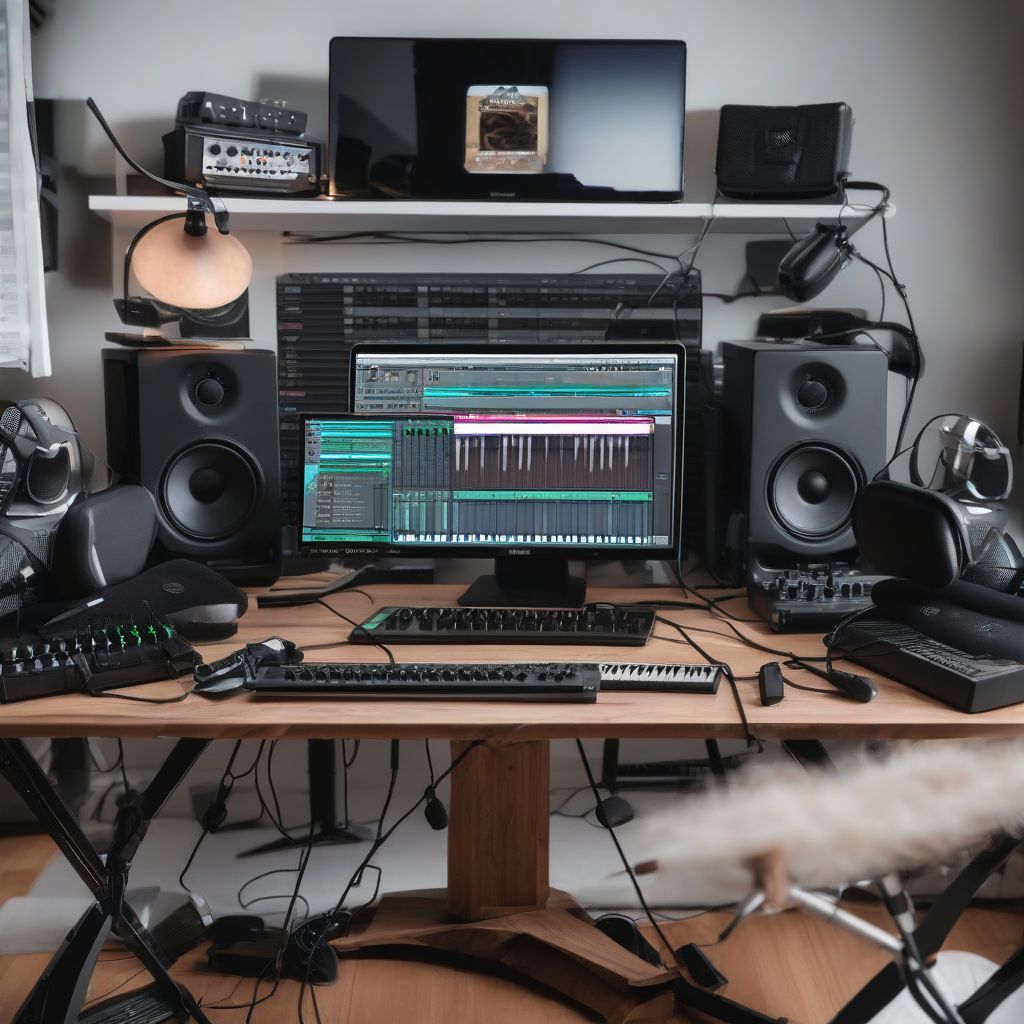Remember that dream you had of producing your own music, podcast, or voice-overs? It felt distant then, right? Like something only professionals with fancy studios could achieve. Well, guess what? That dream is closer than you think! With the right home studio equipment, you can transform any room into a creative hub. Whether you’re just starting out or are a seasoned pro looking to upgrade, this comprehensive guide will equip you with the knowledge to find the perfect gear for your audio production journey.
Essential Home Studio Equipment: Laying the Foundation for Great Sound
Just like a chef needs quality ingredients, crafting professional-sounding audio requires the right tools. Let’s break down the essentials:
1. Microphones: Capturing Your Creative Voice
Consider the microphone your audio paintbrush. It’s your voice’s direct line to your audience, so choosing the right one is crucial.
For Beginners:
- USB Microphones: User-friendly, affordable, and perfect for plugging directly into your computer.
- Recommendation: Blue Yeti USB Microphone
- Dynamic Microphones: Durable, handle high sound pressure levels, and are great for vocals and live instruments.
- Recommendation: Shure SM58
For Pros:
- Condenser Microphones: Known for their sensitivity and detailed sound, ideal for recording vocals and instruments in a treated room.
- Recommendation: Neumann TLM 103
- Ribbon Microphones: Offer a warm, vintage tone often favored for vocals, guitars, and strings.
- Recommendation: Royer R-121
2. Headphones: Your Portal to Pristine Audio
Headphones are essential for monitoring your recordings and making critical mixing decisions without disturbing others.
For Beginners:
- Closed-Back Headphones: Provide excellent sound isolation, crucial for recording and preventing sound leakage.
- Recommendation: Audio-Technica ATH-M50x
- Open-Back Headphones: Offer a wider soundstage, ideal for mixing and mastering when accuracy is paramount.
- Recommendation: Sennheiser HD 600
For Pros:
- Studio Monitor Headphones: Designed for flat frequency response, offering an uncolored representation of your audio.
- Recommendation: Beyerdynamic DT 770 PRO
- Reference Headphones: Used for critical listening and mastering, ensuring your mix translates well across different playback systems.
- Recommendation: Audeze LCD-X
3. Audio Interface: Your Bridge Between Sound and Software
An audio interface acts as the bridge between your microphones, instruments, and computer. It’s essential for converting analog signals to digital and vice versa.
For Beginners:
- 2-Channel USB Audio Interfaces: Compact, affordable, and perfect for solo artists or small setups.
- Recommendation: Focusrite Scarlett 2i2
- Portable Audio Interfaces: Ideal for musicians on the go, offering basic recording capabilities in a compact design.
- Recommendation: PreSonus AudioBox iTwo
For Pros:
- Multi-Channel Audio Interfaces: Offer more inputs and outputs, allowing you to record multiple sources simultaneously.
- Recommendation: Universal Audio Apollo Twin X
- Thunderbolt Audio Interfaces: Provide ultra-low latency and high-speed data transfer, crucial for demanding recording sessions.
- Recommendation: Antelope Audio Discrete 4 Synergy Core
4. Digital Audio Workstation (DAW) Software: Your Virtual Studio
A Digital Audio Workstation (DAW) is the command center of your home studio, where you record, edit, mix, and master your audio.
Popular DAW Options:
- Ableton Live: Known for its intuitive workflow and powerful features, especially for electronic music production.
- Logic Pro X: Exclusive to Mac users, offering a comprehensive suite of tools and instruments for a wide range of genres.
- Pro Tools: The industry-standard DAW used in professional studios worldwide, renowned for its robust recording and editing capabilities.
 Home Studio Setup
Home Studio Setup
5. Studio Monitors: Hearing Your Music with Clarity
Studio monitors are specialized speakers designed to provide an accurate representation of your audio, allowing you to make informed mixing decisions.
For Beginners:
- Entry-Level Studio Monitors: Offer a good balance of affordability and sound quality for smaller home studios.
- Recommendation: KRK Rokit 5 G4
- Active Studio Monitors: Have built-in amplifiers, simplifying setup and reducing clutter.
- Recommendation: Yamaha HS5
For Pros:
- High-End Studio Monitors: Provide exceptional clarity, detail, and a wider frequency response for critical listening.
- Recommendation: Genelec 8040B
- Subwoofers: Extend the low-frequency response of your monitoring system, crucial for accurately hearing bass frequencies.
- Recommendation: Yamaha HS8S
Taking Your Home Studio to the Next Level: Additional Gear for Enhanced Production
Once you’ve covered the essentials, consider these additions to elevate your audio production game:
1. MIDI Keyboard: Unlocking Musical Ideas
A MIDI keyboard allows you to control virtual instruments and software within your DAW, opening a world of creative possibilities.
- Recommendation: Native Instruments Komplete Kontrol A25
2. Pop Filter and Mic Stand: Achieving Vocal Clarity
A pop filter reduces plosives (those harsh “p” and “b” sounds) while a sturdy mic stand ensures optimal microphone placement.
- Recommendation: A combination pack like the Neewer Professional Microphone Pop Filter Mask Shield with Tripod Boom Stand
3. Acoustic Treatment: Creating a Controlled Sounding Environment
Acoustic panels and bass traps help minimize sound reflections and control room acoustics, leading to cleaner recordings and more accurate monitoring.
- Recommendation: Start with a basic acoustic treatment kit and gradually expand as needed.
Choosing the Right Gear for You: Factors to Consider
- Budget: Determine a realistic budget for your home studio equipment, allocating funds wisely based on your priorities.
- Space: Consider the available space in your home studio and choose gear that fits comfortably without compromising functionality.
- Music Genre: Different genres may benefit from specific types of microphones, headphones, or software instruments.
- Skill Level: Opt for user-friendly gear as a beginner and gradually explore more advanced options as your skills grow.
Conclusion: Embrace Your Audio Journey
Building a home studio is an investment in your creative passion. Remember, the most important aspect is to start creating! As you gain experience and refine your craft, your home studio will evolve with you. So, whether you’re recording a podcast, producing a hit song, or adding sound effects to your latest video project, embrace the journey and let your creativity soar!
Ready to take the next step? Explore our in-depth guides on finding affordable and high-quality studio gear and creating a professional recording space.
[amazon bestseller=”audio interface”]
